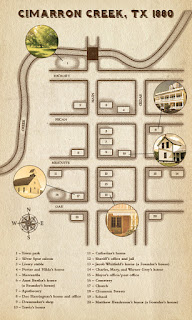It all started when my nephew asked
a seemingly simple question: “Did Emma live in an orphanage?” At the time, all
we knew about Emma’s early life was that she’d emigrated from Sweden to the
United States in the late nineteenth century and had lived in Brooklyn with her
sister.
I’m far from an expert genealogical
researcher, but I do like solving puzzles, so I agreed to see what I could
discover. Little did I know that not only would I learn that Emma had never
spent time in an orphanage, but that the convoluted paths my searching for that
answer took would plant the seeds for the Cimarron Creek trilogy.
As the months passed and I pored
over census reports, ship manifests, old phone directories, and Swedish parish
records, I learned many things about Emma, including the fact that not
everything we’d thought we knew was true. Her sister was only a half-sister,
and while they both lived in Brooklyn, at times only a few blocks apart, they
did not live together.
And then there was her future
husband’s family. Although he’d been born in Brooklyn and was one of many
children, his parents had emigrated – one from Germany, the other from Ireland.
Talk about a melting pot!
There were so many people involved
that I started drafting a crude family tree, then graduated to family tree
software. Each person I added seemed like a small victory, and when I
discovered where many of them were employed as well as where they lived, I felt
as if I had solved a mystery.
Even though some of them had been
dead for more than a century, these people started becoming real to me. That
feeling of actually knowing them increased when I used MapQuest to plot where
everyone lived.
I was so involved in them that I even started dreaming about
them, picturing Emma walking down the streets of Brooklyn to visit her sister
and then taking a side trip to spend time with her sweetheart.
I never found the answers to those
questions, but they started my brain whirling. And that leads us to the
Cimarron Creek trilogy.
You’re probably asking what Emma’s story has to do with
it. After all, that series takes place in the Texas Hill Country, not Brooklyn.
And while one of the characters does travel there from Europe, she comes from
France, not Sweden, Germany, or Ireland.
The seeds that were planted while I
searched for Emma were ones of family connections, long-buried secrets, and the
challenges of making a home in a totally new place.
When I began to outline the trilogy,
my first step was to create a family tree.
I envisioned Cimarron Creek having two
founding families which – of course – intermarried. And, as I developed the
family tree, the secrets that both united and divided my fictional town started
to fall into place. I was on the way to having a plot.
Next came the town map, because I
needed to know where everyone lived and, since I envisioned them walking from
one place to another the way Emma and her sweetheart did, I also needed to know
what the streets were named. Readers have told me that the map helped them
picture the town. Believe me, it helped me too.
What was it like to arrive in a new place,
not knowing anyone, perhaps not being welcomed?
What if your expectations of
your new home were all wrong?
What if you feared you’d made a horrible mistake,
but you had no way of returning to your previous life?
I had one of those aha!
moments that writers love when I realized that a person didn’t have to have
crossed the ocean to have those same feelings.
Lydia, the heroine of A Stolen Heart, is a Yankee
schoolteacher who comes to Cimarron Creek in 1880. Though it’s been fifteen years
since Appomattox, the wounds caused by the Civil War have yet to heal, and
Yankees are not welcome.
Lydia’s traveled from Syracuse, New York, to the Hill
Country to be reunited with her fiancé, only to discover that he’s disappeared
and – worse yet – has married someone else. What is she to do?
The final Cimarron Creek novel, A Tender Hope, brings two new women to town. Thea’s a native-born Texan who wants to start a
new life, one that’s free from the pain of the past. Aimee, who’s spent almost her
entire life in France, has the opposite goal. She comes to Cimarron Creek
seeking her past.
All of these characters face many of
the challenges that Emma did when she reached Brooklyn. They’re strangers who
need to establish new lives in a new place, a place that’s far different from
anywhere they’ve lived. Each of them has secrets that, if revealed, might put
them or others in danger. Each of them seeks love but finds that it’s more
elusive than expected.
Will they find a happily-ever-after as Emma did?
The road they travel isn’t an easy one, but their stories are ones that I found deeply satisfying to tell. And it all began with a simple question.











